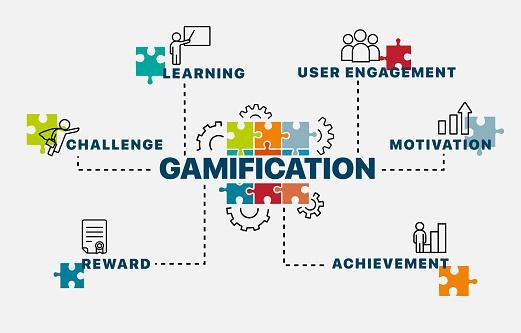- Loghează-te sau înregistrează-te să postezi comentarii
We hear from parents, and sometimes even teachers, that there is no place for play in school, that kindergarteners play, schoolchildren learn, that school is serious. The term 'gamification' itself is relatively new, just as gamification as a teaching method is relatively new in schools.

Source: akshatsinghbisht.com
In education, gamification means introducing a playful element into lessons, for example by using a quiz game to assess pupils' performance instead of a question time. The aim is to engage and motivate learners, not through a specific game, but by using playful elements.
Well-chosen playful elements stimulate emotional fibres, increase performance, strengthen intrinsic motivation and develop creativity. People instinctively like to play because of the pleasure of novelty, of exploring unknown territories, of challenging and exciting adventures.
In rethinking the social inclusion of net-generation, it is crucial to recognise that intrinsic motivation mechanisms, which gamification is particularly well suited to activate, are much more effective and long-lasting than extrinsic motivation. At the same time, the use of gamification is also facilitated by wide range of digital tools freely available on the Internet, which can be easily integrated into the lessons by the teachers.
The pedagogical benefits of gamification:
- Mistakes are not punished, unlike most school methods, and positive feedback is a fundamental element of play.
- Games create a virtual reality that helps students gain experience more easily in contrast to the sterile school environment.
- There is no exam pressure in games to set back student performance.
I needs higher level of activity and interaction from both students and teachers:
- develop independence
- help to set short and long-term goals
- provide immediate feedback
- act as an antidote to boredom
- they provide pleasure by allowing you to try more than once
- information is more effectively retained
A key driver of gamification is the ability to give rewards for completing certain tasks, which can take different forms. The point system can be used to focus on progression, or accumulation and hoarding. Traditional, grade-based assessment calculates averages (of the achievements accumulated over the year), whereas points-based assessment allows the students to experience and visualise a sense of growth and progress. In such an environment, the student will not reflect on a lower grade as a failure, but as a step closer to the next level.
The most important thing is the teacher's pedagogical awareness: the place and role of games in learning must be clearly understood. Students should not play only for the game's sake, and should not avoid work leading to deeper knowledge (e.g. repetition, practice).
The use of digital games for learning purposes requires at least an intermediate level of digital literacy from teachers and students alike. Given the fact that, in addition to learning, assessment is also done with digital tools, gamification also develops digital skills, among other very important competences.
How to plan the gamification? The structure of a traditional lesson should be made interactive, with stakes, rules and scores, virtual rewards, individual or group materials. A simple example: students are asked to complete a traditional test, but they receive it via email or an app. They can score points or receive a receipt indicating their progress and performance in a given section.
Another way to gamify is to search for QR codes. QR codes can be hidden in the classroom or school for students to find. The codes contain information and instructions on where to find the next code. Students have to solve a task, answer a question or decide whether the information they have received is true or false. Those who find the codes and thus solve the problems are awarded points, a diploma or another type of reward.
Flash questions: throughout the learning process, students can answer flash questions. Those who answer correctly receive points or a piece of a puzzle. At the end of the semester, the points or the puzzle can be converted into a grade.
Gamification, which does not take the time of traditional lessons, can have much greater pedagogical benefits. In the case of individual or group student projects, a wide range of strategic games are available to develop broader knowledge and competences behind the subjects.
